Wei-Chiu Ma
Beyond the Frame: Generating 360° Panoramic Videos from Perspective Videos
Apr 10, 2025Abstract:360{\deg} videos have emerged as a promising medium to represent our dynamic visual world. Compared to the "tunnel vision" of standard cameras, their borderless field of view offers a more complete perspective of our surroundings. While existing video models excel at producing standard videos, their ability to generate full panoramic videos remains elusive. In this paper, we investigate the task of video-to-360{\deg} generation: given a perspective video as input, our goal is to generate a full panoramic video that is consistent with the original video. Unlike conventional video generation tasks, the output's field of view is significantly larger, and the model is required to have a deep understanding of both the spatial layout of the scene and the dynamics of objects to maintain spatio-temporal consistency. To address these challenges, we first leverage the abundant 360{\deg} videos available online and develop a high-quality data filtering pipeline to curate pairwise training data. We then carefully design a series of geometry- and motion-aware operations to facilitate the learning process and improve the quality of 360{\deg} video generation. Experimental results demonstrate that our model can generate realistic and coherent 360{\deg} videos from in-the-wild perspective video. In addition, we showcase its potential applications, including video stabilization, camera viewpoint control, and interactive visual question answering.
From an Image to a Scene: Learning to Imagine the World from a Million 360 Videos
Dec 10, 2024Abstract:Three-dimensional (3D) understanding of objects and scenes play a key role in humans' ability to interact with the world and has been an active area of research in computer vision, graphics, and robotics. Large scale synthetic and object-centric 3D datasets have shown to be effective in training models that have 3D understanding of objects. However, applying a similar approach to real-world objects and scenes is difficult due to a lack of large-scale data. Videos are a potential source for real-world 3D data, but finding diverse yet corresponding views of the same content has shown to be difficult at scale. Furthermore, standard videos come with fixed viewpoints, determined at the time of capture. This restricts the ability to access scenes from a variety of more diverse and potentially useful perspectives. We argue that large scale 360 videos can address these limitations to provide: scalable corresponding frames from diverse views. In this paper, we introduce 360-1M, a 360 video dataset, and a process for efficiently finding corresponding frames from diverse viewpoints at scale. We train our diffusion-based model, Odin, on 360-1M. Empowered by the largest real-world, multi-view dataset to date, Odin is able to freely generate novel views of real-world scenes. Unlike previous methods, Odin can move the camera through the environment, enabling the model to infer the geometry and layout of the scene. Additionally, we show improved performance on standard novel view synthesis and 3D reconstruction benchmarks.
Sparse Voxels Rasterization: Real-time High-fidelity Radiance Field Rendering
Dec 05, 2024Abstract:We propose an efficient radiance field rendering algorithm that incorporates a rasterization process on sparse voxels without neural networks or 3D Gaussians. There are two key contributions coupled with the proposed system. The first is to render sparse voxels in the correct depth order along pixel rays by using dynamic Morton ordering. This avoids the well-known popping artifact found in Gaussian splatting. Second, we adaptively fit sparse voxels to different levels of detail within scenes, faithfully reproducing scene details while achieving high rendering frame rates. Our method improves the previous neural-free voxel grid representation by over 4db PSNR and more than 10x rendering FPS speedup, achieving state-of-the-art comparable novel-view synthesis results. Additionally, our neural-free sparse voxels are seamlessly compatible with grid-based 3D processing algorithms. We achieve promising mesh reconstruction accuracy by integrating TSDF-Fusion and Marching Cubes into our sparse grid system.
Coarse Correspondence Elicit 3D Spacetime Understanding in Multimodal Language Model
Aug 01, 2024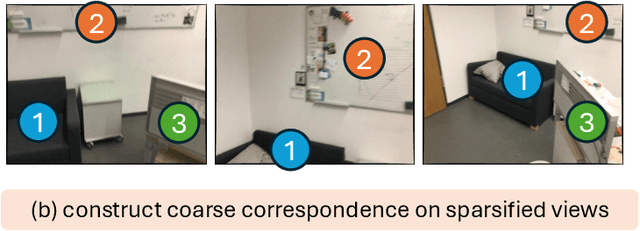
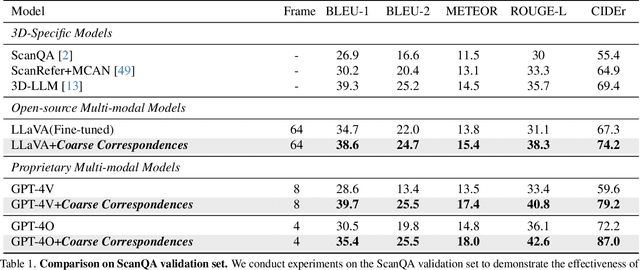
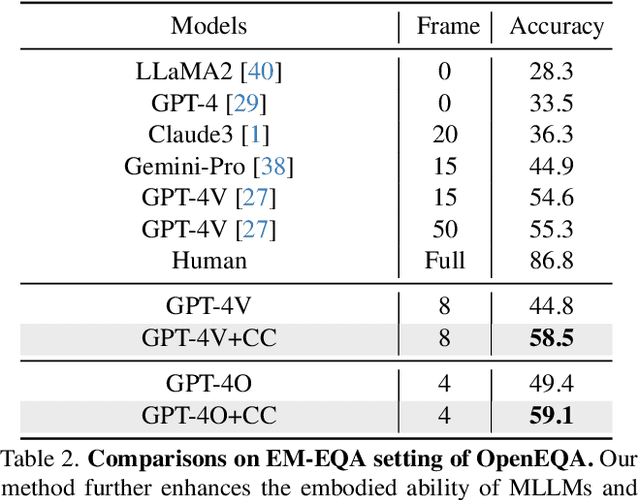
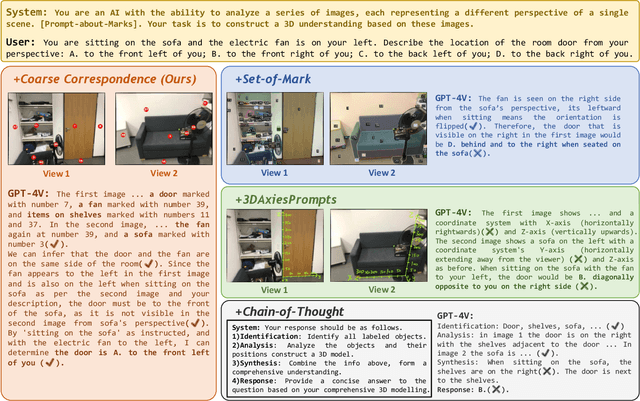
Abstract:Multimodal language models (MLLMs) are increasingly being implemented in real-world environments, necessitating their ability to interpret 3D spaces and comprehend temporal dynamics. Despite their potential, current top models within our community still fall short in adequately understanding spatial and temporal dimensions. We introduce Coarse Correspondence, a simple, training-free, effective, and general-purpose visual prompting method to elicit 3D and temporal understanding in multimodal LLMs. Our method uses a lightweight tracking model to find object correspondences between frames in a video or between sets of image viewpoints. It selects the most frequent object instances and visualizes them with markers with unique IDs in the image. With this simple approach, we achieve state-of-the-art results on 3D understanding benchmarks including ScanQA (+20.5\%) and a subset of OpenEQA (+9.7\%), and on long-form video benchmarks such as EgoSchema (+6.0\%). We also curate a small diagnostic dataset to evaluate whether MLLMs can reason about space from a described viewpoint other than the camera viewpoint. Again, Coarse Correspondence improves spatial perspective-taking abilities but we highlight that MLLMs struggle with this task. Together, we demonstrate that our simple prompting method can significantly aid downstream tasks that require 3D or temporal reasoning.
Task Me Anything
Jun 17, 2024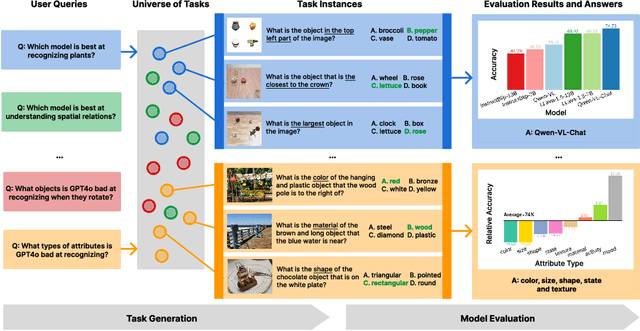

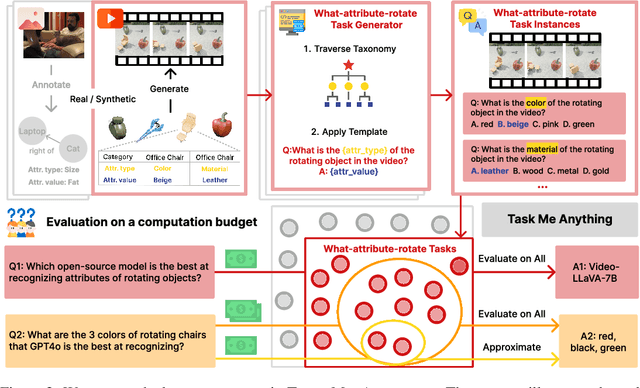

Abstract:Benchmarks for large multimodal language models (MLMs) now serve to simultaneously assess the general capabilities of models instead of evaluating for a specific capability. As a result, when a developer wants to identify which models to use for their application, they are overwhelmed by the number of benchmarks and remain uncertain about which benchmark's results are most reflective of their specific use case. This paper introduces Task-Me-Anything, a benchmark generation engine which produces a benchmark tailored to a user's needs. Task-Me-Anything maintains an extendable taxonomy of visual assets and can programmatically generate a vast number of task instances. Additionally, it algorithmically addresses user queries regarding MLM performance efficiently within a computational budget. It contains 113K images, 10K videos, 2K 3D object assets, over 365 object categories, 655 attributes, and 335 relationships. It can generate 750M image/video question-answering pairs, which focus on evaluating MLM perceptual capabilities. Task-Me-Anything reveals critical insights: open-source MLMs excel in object and attribute recognition but lack spatial and temporal understanding; each model exhibits unique strengths and weaknesses; larger models generally perform better, though exceptions exist; and GPT4o demonstrates challenges in recognizing rotating/moving objects and distinguishing colors.
Preserving Identity with Variational Score for General-purpose 3D Editing
Jun 13, 2024Abstract:We present Piva (Preserving Identity with Variational Score Distillation), a novel optimization-based method for editing images and 3D models based on diffusion models. Specifically, our approach is inspired by the recently proposed method for 2D image editing - Delta Denoising Score (DDS). We pinpoint the limitations in DDS for 2D and 3D editing, which causes detail loss and over-saturation. To address this, we propose an additional score distillation term that enforces identity preservation. This results in a more stable editing process, gradually optimizing NeRF models to match target prompts while retaining crucial input characteristics. We demonstrate the effectiveness of our approach in zero-shot image and neural field editing. Our method successfully alters visual attributes, adds both subtle and substantial structural elements, translates shapes, and achieves competitive results on standard 2D and 3D editing benchmarks. Additionally, our method imposes no constraints like masking or pre-training, making it compatible with a wide range of pre-trained diffusion models. This allows for versatile editing without needing neural field-to-mesh conversion, offering a more user-friendly experience.
ExtraNeRF: Visibility-Aware View Extrapolation of Neural Radiance Fields with Diffusion Models
Jun 10, 2024Abstract:We propose ExtraNeRF, a novel method for extrapolating the range of views handled by a Neural Radiance Field (NeRF). Our main idea is to leverage NeRFs to model scene-specific, fine-grained details, while capitalizing on diffusion models to extrapolate beyond our observed data. A key ingredient is to track visibility to determine what portions of the scene have not been observed, and focus on reconstructing those regions consistently with diffusion models. Our primary contributions include a visibility-aware diffusion-based inpainting module that is fine-tuned on the input imagery, yielding an initial NeRF with moderate quality (often blurry) inpainted regions, followed by a second diffusion model trained on the input imagery to consistently enhance, notably sharpen, the inpainted imagery from the first pass. We demonstrate high-quality results, extrapolating beyond a small number of (typically six or fewer) input views, effectively outpainting the NeRF as well as inpainting newly disoccluded regions inside the original viewing volume. We compare with related work both quantitatively and qualitatively and show significant gains over prior art.
Multilingual Diversity Improves Vision-Language Representations
May 27, 2024Abstract:Massive web-crawled image-text datasets lay the foundation for recent progress in multimodal learning. These datasets are designed with the goal of training a model to do well on standard computer vision benchmarks, many of which, however, have been shown to be English-centric (e.g., ImageNet). Consequently, existing data curation techniques gravitate towards using predominantly English image-text pairs and discard many potentially useful non-English samples. Our work questions this practice. Multilingual data is inherently enriching not only because it provides a gateway to learn about culturally salient concepts, but also because it depicts common concepts differently from monolingual data. We thus conduct a systematic study to explore the performance benefits of using more samples of non-English origins with respect to English vision tasks. By translating all multilingual image-text pairs from a raw web crawl to English and re-filtering them, we increase the prevalence of (translated) multilingual data in the resulting training set. Pre-training on this dataset outperforms using English-only or English-dominated datasets on ImageNet, ImageNet distribution shifts, image-English-text retrieval and on average across 38 tasks from the DataComp benchmark. On a geographically diverse task like GeoDE, we also observe improvements across all regions, with the biggest gain coming from Africa. In addition, we quantitatively show that English and non-English data are significantly different in both image and (translated) text space. We hope that our findings motivate future work to be more intentional about including multicultural and multilingual data, not just when non-English or geographically diverse tasks are involved, but to enhance model capabilities at large.
BLINK: Multimodal Large Language Models Can See but Not Perceive
Apr 18, 2024



Abstract:We introduce Blink, a new benchmark for multimodal language models (LLMs) that focuses on core visual perception abilities not found in other evaluations. Most of the Blink tasks can be solved by humans "within a blink" (e.g., relative depth estimation, visual correspondence, forensics detection, and multi-view reasoning). However, we find these perception-demanding tasks cast significant challenges for current multimodal LLMs because they resist mediation through natural language. Blink reformats 14 classic computer vision tasks into 3,807 multiple-choice questions, paired with single or multiple images and visual prompting. While humans get 95.70% accuracy on average, Blink is surprisingly challenging for existing multimodal LLMs: even the best-performing GPT-4V and Gemini achieve accuracies of 51.26% and 45.72%, only 13.17% and 7.63% higher than random guessing, indicating that such perception abilities have not "emerged" yet in recent multimodal LLMs. Our analysis also highlights that specialist CV models could solve these problems much better, suggesting potential pathways for future improvements. We believe Blink will stimulate the community to help multimodal LLMs catch up with human-level visual perception.
Video2Game: Real-time, Interactive, Realistic and Browser-Compatible Environment from a Single Video
Apr 15, 2024Abstract:Creating high-quality and interactive virtual environments, such as games and simulators, often involves complex and costly manual modeling processes. In this paper, we present Video2Game, a novel approach that automatically converts videos of real-world scenes into realistic and interactive game environments. At the heart of our system are three core components:(i) a neural radiance fields (NeRF) module that effectively captures the geometry and visual appearance of the scene; (ii) a mesh module that distills the knowledge from NeRF for faster rendering; and (iii) a physics module that models the interactions and physical dynamics among the objects. By following the carefully designed pipeline, one can construct an interactable and actionable digital replica of the real world. We benchmark our system on both indoor and large-scale outdoor scenes. We show that we can not only produce highly-realistic renderings in real-time, but also build interactive games on top.
 Add to Chrome
Add to Chrome Add to Firefox
Add to Firefox Add to Edge
Add to Edge